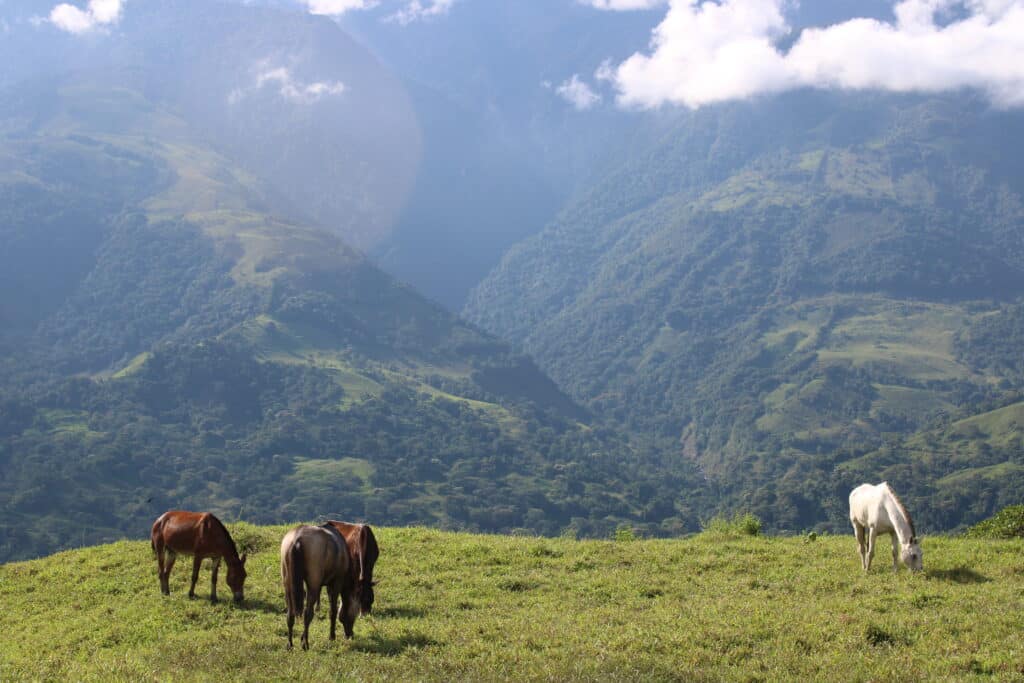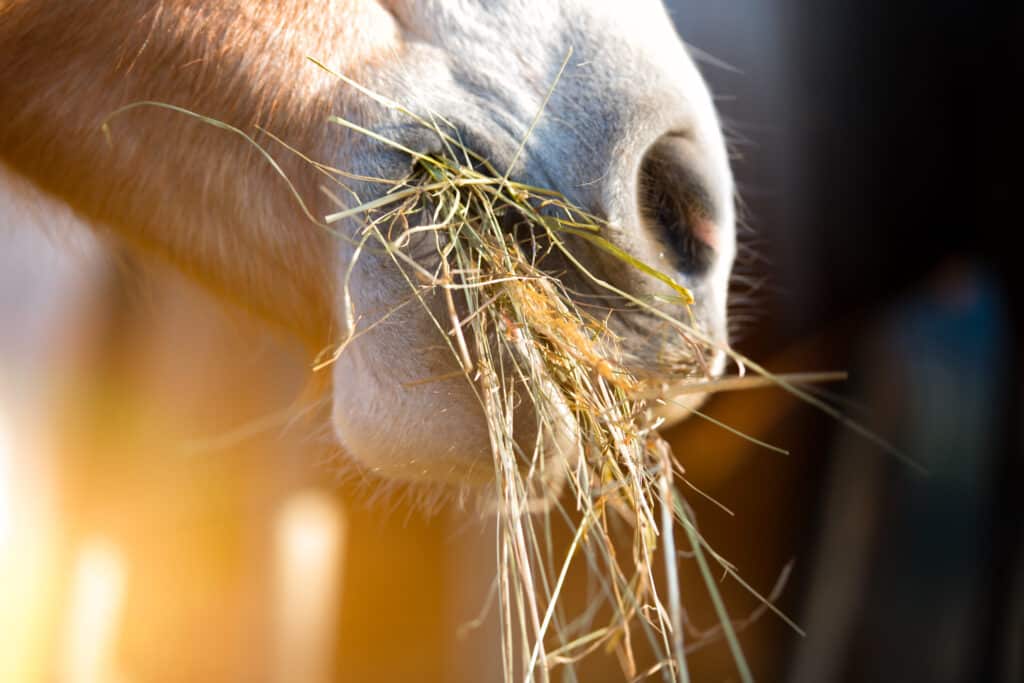Uncategorized
Reduce Digestive Issues
GET FAMILIAR WITH YOUR HORSE’S DIGESTIVE SYSTEM SO YOU CAN MAKE THE RIGHT CHOICES FOR YOUR BEST FRIEND
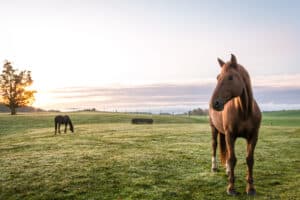 Horses are strict herbivores, grazing on good quality pasture or being supplied good quality hays will ensure a healthy digestive system. Once we move away from the idea of feeding roughage within a short time start we begin to experience problems with our horse’s digestive system. This can lead to serious problems such as ulcers, diarrhoea, choke and worst of all colic.
Horses are strict herbivores, grazing on good quality pasture or being supplied good quality hays will ensure a healthy digestive system. Once we move away from the idea of feeding roughage within a short time start we begin to experience problems with our horse’s digestive system. This can lead to serious problems such as ulcers, diarrhoea, choke and worst of all colic.
We suggest feeding a feed that is not wet or soaked because this does not encourage the normal process at the point of the mouth and the mouth is the first contact your horse makes with his feed. If you are using supplements you will be required to dampen the feed, but this means damp bordering on dry, not wet or soaked.
When one first looks at the horses digestive tract you could be excused for thinking that it was a mistake. I always say that whoever created the horse’s digestive system must have been on drugs. But seriously take the equine stomach, it is very small considering the size of the horse and only has a small capacity very similar to that of a Waitrose or Tesco shopping bag, not very big. The small intestine is approximately 22 meters in length if you were to stretch it out and only has a diameter of 10 cm and a capacity of approximately 45 L. We know quite a bit about the anatomy and physiology of the GI tract and it does seem a little bit out of whack. But in the wild as nature had intended the horse will survive extremely well because he or she is not expected to ingest large amounts of feed at one time, but rather is out grazing continually moving around stopping to rest when required, to drink and sleep.
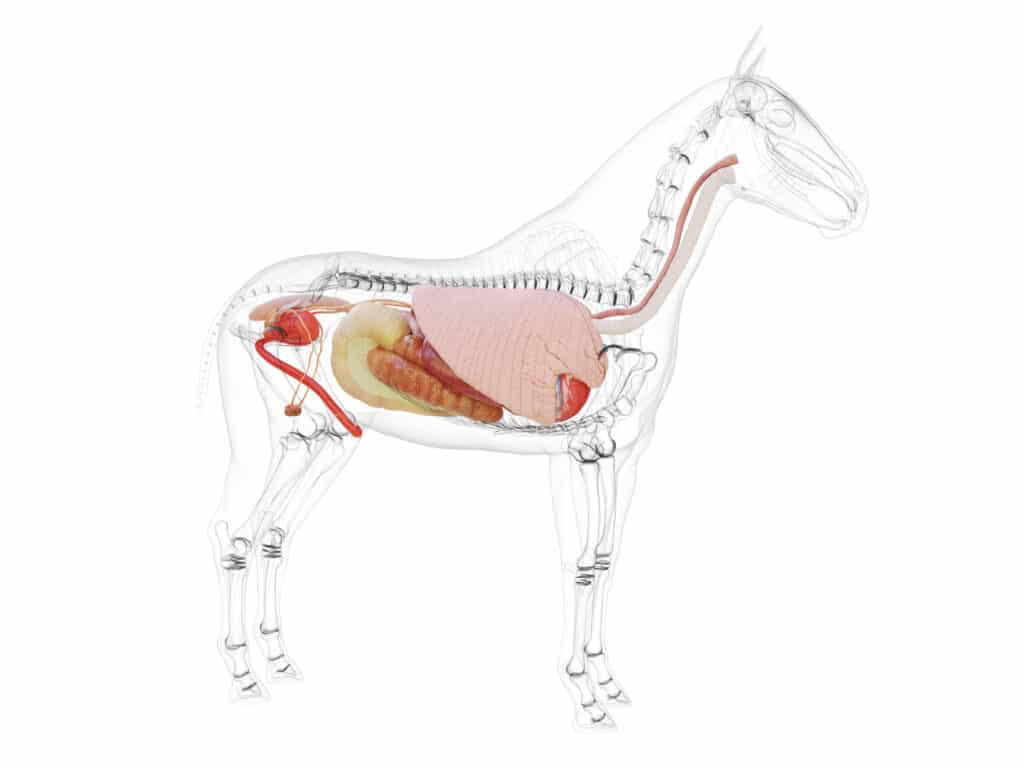
Roughage is undoubtedly the most important basis of the equine diet and horses really should consume approximately 1.5 to 3% of their body weight on a daily basis, it is recommended that at least half of horse’s diet should be roughage in the form of hay or pasture. The equine gastrointestinal system is easily upset and if sudden changes are made in the diet it can definitely increase the risk of colic and other digestive issues.
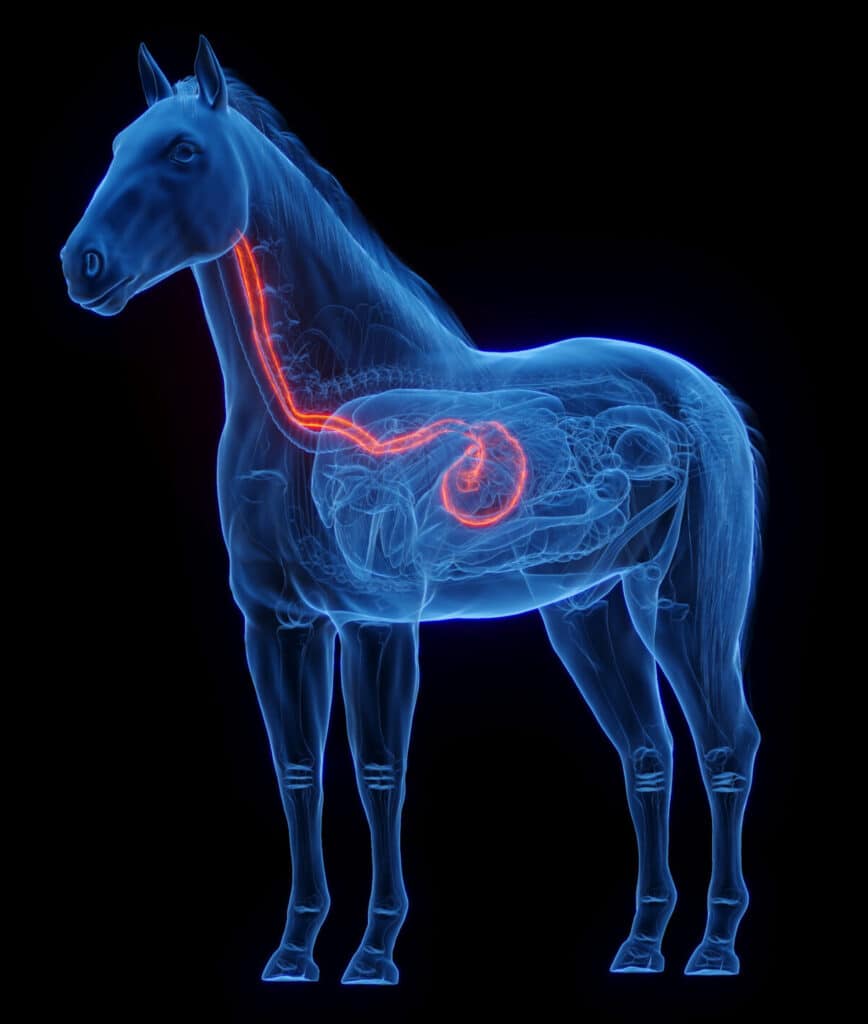
So why don’t we take a closer look at how the equine digestive system functions? We will also find the link between the horse’s physiology and his or her daily nutritional intake. When a horse takes food into the mouth, whether it is grass, hay or grain the feed is pushed to the back of the mouth. The horse’s molars then grind the feed and this is where the enzymatic action begins, creating saliva which begins the process of digestion. Even at this point there is the beginning of a breakdown of starch. If you give your horse a handful of whole oats he would chew and grind this very quickly, once chewed the oats will have absorbed its own weight in moisture. Hay on the other hand will absorb approximately 4 times its own weight.
The food is then pushed by the tongue past the soft palate into the pharynx which is the opening to the oesophagus, this is a flexible tube that runs down the neck and into the stomach. There are a number of muscular contractions which push the food along. Because the contractions only move in one direction the feed only goes one-way.
Only a small amount of digestion takes place in the stomach, there is a small microbial population which does assist with fermentation and a small amount of enzymatic action, however the food only remains for a short time in the stomach, approximately 15 minutes on average. It then makes its way to the small intestine so there is little time for much breakdown of food.
Once the stomach is approximately 2/3 full it then starts to pass food into the small intestine this process continues as long as the horse is eating and by the time it reaches the small intestine it would have been liquefied by acids in the stomach.
Even though the horse’s feed remains in the stomach for a brief time it does have quite a bearing on the horse’s health.
The upper and inner portion of the stomach’s lining consists of non-glandular, squamous cell layers; these are very susceptible to hydrochloric acid which the stomach secretes. If there is food contained in the stomach at frequent intervals the acid in the stomach tends to be absorbed. However, horse’s fed only once or twice daily with large feeds have a much higher risk of gastric ulcers and other digestive upsets. Roughage in the form of good quality hays or pasture does the best job of absorbing the stomach acids. So therefore horses on a high roughage diet have less risk of developing ulcers.
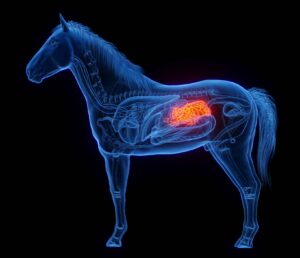
From here we follow down to the small intestine which is a complicated tube hanging from the loin area by a membrane, shaped similar to a fan which is called the mesentery. The duodenum shaped like a U-turn, is the first part of the small intestine, this shape helps to prevent food been forced back into the stomach should the small intestine become distended. Most of the protein digestion takes place in the small intestine as does the absorption of amino acids; however some grains are processed more efficiently in the small intestine than roughage. The small intestine can hold up to 30% of the gastrointestinal tract’s capacity.
Within the small intestine food is broken down by enzymes. Starch which has not already been digested by saliva is then converted into a simple sugar called maltose, other types of complex sugars and carbohydrates will then be broken down into a simple form of sugar to enable them to be absorbed through the intestinal wall. They are then transported in the blood and will eventually arrive at the liver which is the horse’s major chemical processing plant. Did you know that the liver is an amazing body organ being able to regenerate almost 75 to 85% of itself it is responsible for many functions within the body and this also includes the association with bowel function. The liver is capable of reorganising and sorting amino acids into protein and is able to bind water-soluble nutrients to their suitable transporters to enable them to be distributed throughout the body.
The main location for the digestion and absorption of fats is the small intestine. Most humans and animals use the gallbladder secretions to assist with the breakdown of fats however the horse does not have a gallbladder which is another strange fact, horses however seem to use diets containing 10 to 15% fat extremely efficiently in particular for energy and weight gain. Fat-soluble vitamins A,D,E and K are absorbed in the small intestine as are calcium some phosphorus and B group items . It takes approximately 1 hour to an hour and a half for food which is now liquefied to pass through the length of the small intestine.
The ileum is the last part of the small intestine which then leads to the hindgut. This part is made up of the cecum, large (or ascending) colon, small colon, rectum, and anus. This is where the hardest work is performed of the whole digestive process. Enzymes do not play the lead role here, due to the fact that the digestion in the hindgut is largely microbial. This is performed by a large population of billions of symbiotic bacteria, that very efficiently break down fibre into smaller components which are called volatile fatty acids. This allows absorption through the gut wall. This is a natural process and is also essential for a healthy digestive system.
The caecum, is approximately 1.2 m long and has a capacity of around 30 L this plays a huge role in the first stage of hindgut digestion. The caecum is located high in the horses right flank and extends down and forward towards the diaphragm. Hard to digest molecules and Plant fibres composed of cellulose and other molecules travel through the stomach and small intestine and are unaffected by enzymes. However when they reach the fermentation vat of the caecum that huge bacteria population makes short work of them, they are usually broken down within about five hours. The caecum has the ability to slow the passage of food to enable the microbes to perform their work.
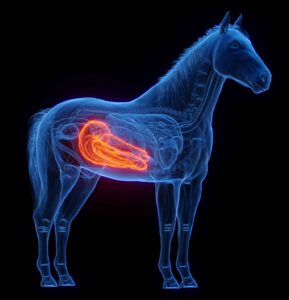
Partly digestive food then travels from the caecum to the large colon this is where the fermentation continues. It is almost 3.6 m in length and has an incredible volume of approximately 50 to 60 L this is approximately 38% of the GI tract’s total capacity. It is in the large colon where food remains for the longest period of time approximately 36 to 48 hours. It has a construction that resembles a series of pouches and is capable of breaking down large volumes of fibrous material; however it can also become a risk factor if the pouches become distended trapping gas during a bout of colic. It is quite apparent that they are almost custom-made for twisting and strangulating their own tissues! The food then moves to the small colon once it has been fully processed which is approximately 3.6 m long, however it is a small diameter approximately 10 cm. Most of the nutrients have been absorbed by this time but whatever is left in the horse’s gut, the horse will be unable to digest. This part of the hindgut is used to reclaim excess moisture from the remaining material. Once the food leaves the small colon it has become solid again and has been formed into faecal balls. Approximately 36 to 72 hours after the horse first consumed his or her food this waste material is expelled as manure
Because the horse’s gastrointestinal tract is very sensitive any change in the horse’s diet must be done slowly not quickly, the reason for this is that it can compromise the gut bacteria population. If these bacteria start dying off there is an increased risk of colic and the horse would not be receiving the correct nutritional intake. We already know that the horse’s gastrointestinal tract must be treated with great respect. For those of you who have experienced a horse with colic you will know that it is a very distressing time for both the horse and the horse owner. So preventative measures are always the best option in the management of your horse’s health.
There are other triggers that can create digestive upsets in horses; this can include feeding a horse a high carbohydrate diet that is lacking in roughage. For example feeding a horse a high grain diet, as is often the case with stabled horses and insufficient roughage might mean that the small intestine may not be able to process the feed efficiently prior to it reaching the hindgut. The possible end result could be that when carbohydrates reach the fermentation process in the caecum that there could be a lactic acid build up. A lactic acid build up can have an effect on hindgut pH level this can make it difficult for bacteria to survive. During this process there can be a release of endotoxins which can be very harmful for the horse.
This can create a hostile environment and will put the horse at risk for colic or laminitis. Feeding small feeds often with plenty of roughage may well be a solution to this type of problem. I am often asked this question ‘what do I really need to feed my horse’? Well it’s really simple, it’s not rocket science is just common sense. We need to remind ourselves that horses have evolved to eat only one way and that the anatomy and physiology has not changed.
What has changed is man’s intervention producing different types of feeds that in many cases are not suitable to feed to our horses. The big commercial, moneymaking drive, using by-products in feeds because they are easy to access and cheap to purchase and can bulk up a feed. However these types of by-products are simply not suitable to feed to horses.
By-products will include bran, sugar beet, copra meal, soy hulls, whey powder and in some cases fish products. All of these products are not suitable to feed to your horse.
Many of these products require soaking, these products tend to expand but most importantly it does not encourage that normal chewing and grinding process that we talked about at the point of the mouth. Feeding a feed that is too wet will discourage this process and hence create a lot of the problems.
Horses are actually very simple to feed the most important rule to remember that they should consume around 1.5 to 3% of their own body weight in feed each day. At least half of this but preferably a lot more than half should be roughage.
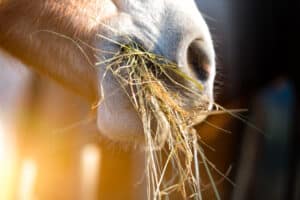
Genetics only have a small bearing on disease states in humans and animals, the major influences are the environment in which the horse lives, toxicity in any way, water quality, quality of feed, and reducing oxidative stress. So what does horse need? Your horse requires a well-balanced ration, one that you can alter and adjust when required and one that contains high-quality roughage, possibly some grains depending on the horse’s workload, fresh clean water, good quality pasture and good quality hay in particular when the pasture is poor.
I love alfalfa because it is low in NSC and starch, it is also highly nutritious and really good value for money. Best of all horses love it. Remember the key to a healthy horse is a good level of roughage this will maintain a healthy digestive system in the long-term.
Does your horse require grain? Well if he was a paleo horse, he would not be allowed grain. But all jokes aside grain is necessary in many cases to provide a good level of carbohydrate that otherwise may not be achieved by simply feeding roughage. However many horses do very well on a simple roughage-based diet. I always recommend using a natural daily supplement but one that has science behind it and also a company that has a transparency about the information provided to customers.
Many horses require a high level of carbohydrates to perform the work expected of them. Horses working 4 to 5 hours a week for example will possibly need extra grain in their diet. My most favourite grain is always oats because you can feed them whole, they are low in starch and they are the lowest in protein of all the grains. Oats are very readily digested and utilised by the horse. Feeding steamed and rolled barley is another option but I don’t feel you require any other grains apart from these two. Let’s face it they are tried and tested and have been used for centuries, they’re safe and easy to feed.
If you are looking to increase weight with a problematic horse products such as EquiSoy which is a full fat de-bittered soy flour is an ideal option and is only required in small amounts.
A daily formula will depend on the performance required from the horse, so if a horse is in work then for this horse then we would normally recommend Oxydane. For horses retired horses we would recommend LeisureVit..
Thank you for reading and happy riding.
Antoinette Foster
